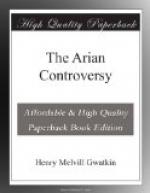[Sidenote: Rival council of Philippopolis.]
Meanwhile the Easterns (such was their haste) halted for some weeks at Philippopolis to issue their own encyclical, falsely dating it from Sardica. They begin with their main argument, that the acts of councils are irreversible. Next they recite the charges against Athanasius and Marcellus, and the doings of the Westerns at Sardica. Hereupon they denounce Hosius, Julius, and others as associates of heretics and patrons of the detestable errors of Marcellus. A few random charges of gross immorality are added, after the Eusebian custom. They end with a new creed, the fourth of Antioch, with some verbal changes, and seven anathemas instead of two.
[Sidenote: The fifth creed of Antioch (344).]
The quarrel of East and West seemed worse than ever. The Eusebians had behaved discreditably enough, but they had at least frustrated the council, and secured a recognition of their creed from a large body of Eastern conservatives. So far they had been fairly successful, but the next move on their side was a blunder and worse. When the Sardican envoys, Vincent of Capua and Euphrates of Cologne, came eastward in the spring of 344, a harlot was brought one night into their lodgings. Great was the scandal when the plot was traced up to the Eusebian leader, Stephen of Antioch. A new council was held, by which Stephen was deposed and Leontius the Lucianist, himself the subject of an old scandal, was raised to the vacant see. The fourth creed of Antioch was also re-issued with a few changes, but followed by long paragraphs of explanation. The Easterns adhered to their condemnation of Marcellus, and joined with him his disciple Photinus of Sirmium, who had made the Lord a mere man like the Ebionites. On the other hand, they condemned several Arian phrases, and insisted in the strongest manner on the mutual, inseparable, and, as it were, organic union of the Son with the Father in a single deity.
[Sidenote: Return of Athanasius (Oct. 346).]
This conciliatory move cleared the way for a general suspension of hostilities. Stephen’s crime had discredited the whole gang of Eastern court intriguers who had made the quarrel. Nor were the Westerns unreasonable. Though they still upheld Marcellus, they frankly gave up and condemned Photinus. Meanwhile Constans pressed the execution of the decrees of Sardica, and Constantius, with a Persian war on his hands, could not refuse. The last obstacle




